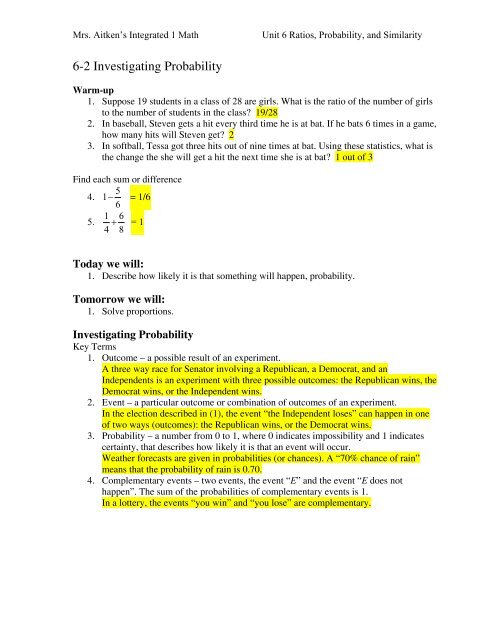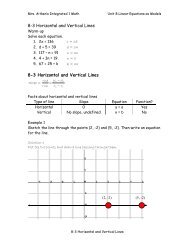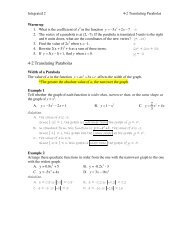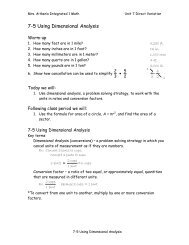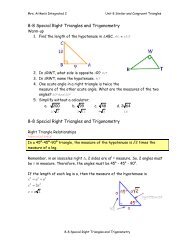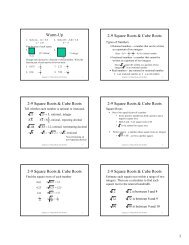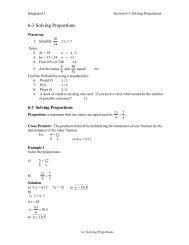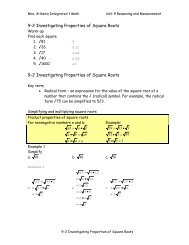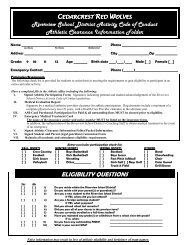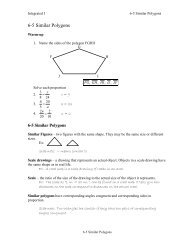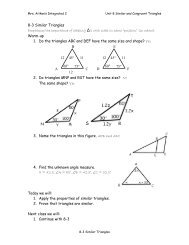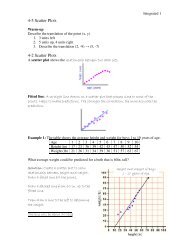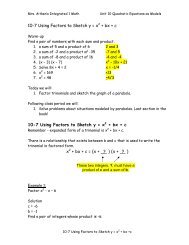6-2 Investigating Probability notes
6-2 Investigating Probability notes
6-2 Investigating Probability notes
Create successful ePaper yourself
Turn your PDF publications into a flip-book with our unique Google optimized e-Paper software.
Mrs. Aitken’s Integrated 1 Math<br />
Unit 6 Ratios, <strong>Probability</strong>, and Similarity<br />
6-2 <strong>Investigating</strong> <strong>Probability</strong><br />
Warm-up<br />
1. Suppose 19 students in a class of 28 are girls. What is the ratio of the number of girls<br />
to the number of students in the class? 19/28<br />
2. In baseball, Steven gets a hit every third time he is at bat. If he bats 6 times in a game,<br />
how many hits will Steven get? 2<br />
3. In softball, Tessa got three hits out of nine times at bat. Using these statistics, what is<br />
the change the she will get a hit the next time she is at bat? 1 out of 3<br />
Find each sum or difference<br />
5<br />
4. 1− = 1/6 6<br />
5.<br />
1 6<br />
+ = 1<br />
4 8<br />
Today we will:<br />
1. Describe how likely it is that something will happen, probability.<br />
Tomorrow we will:<br />
1. Solve proportions.<br />
<strong>Investigating</strong> <strong>Probability</strong><br />
Key Terms<br />
1. Outcome – a possible result of an experiment.<br />
A three way race for Senator involving a Republican, a Democrat, and an<br />
Independents is an experiment with three possible outcomes: the Republican wins, the<br />
Democrat wins, or the Independent wins.<br />
2. Event – a particular outcome or combination of outcomes of an experiment.<br />
In the election described in (1), the event “the Independent loses” can happen in one<br />
of two ways (outcomes): the Republican wins, or the Democrat wins.<br />
3. <strong>Probability</strong> – a number from 0 to 1, where 0 indicates impossibility and 1 indicates<br />
certainty, that describes how likely it is that an event will occur.<br />
Weather forecasts are given in probabilities (or chances). A “70% chance of rain”<br />
means that the probability of rain is 0.70.<br />
4. Complementary events – two events, the event “E” and the event “E does not<br />
happen”. The sum of the probabilities of complementary events is 1.<br />
In a lottery, the events “you win” and “you lose” are complementary.
Mrs. Aitken’s Integrated 1 Math<br />
Unit 6 Ratios, <strong>Probability</strong>, and Similarity<br />
Experimental <strong>Probability</strong><br />
Experimental probability – probability that is based on the results of an experiment, an<br />
activity in which data is observed and recorded.<br />
Researchers find that a medicine they are testing improved the condition of 270 out of 300<br />
patients. Using experimental probability, they conclude that the probability the medicine will<br />
help a patient who takes it is 270 0.9 or 90%<br />
300 =<br />
The experimental probability of an event E can be calculated using the formula<br />
number of times event E occurs<br />
PE ( ) =<br />
number of times the experiment is done<br />
The more times the experiment is conducted, the more reliable is the computed value of<br />
P(E).<br />
Example 1<br />
A vending machine dispenses five different types of fruit drinks. The owner of the machine<br />
has kept records on the last 2000 sales from the machine.<br />
Fruit Punch 746<br />
Citrus Punch 524<br />
Apple Juice 98<br />
Orange Juice 282<br />
Cranberry Juice 350<br />
What is the probability that a randomly-chosen purchase from the machine will be a punch?<br />
Solution<br />
Of the five types of juice, two are punches: fruit punch and citrus punch.<br />
number of times a punch was purchased<br />
P (purchasing a punch) =<br />
number of times a purchase was made<br />
746 + 525 1270<br />
= = 0.635<br />
2000 2000<br />
The probability that a punch is bought is 0.635 or 63 ½%
Mrs. Aitken’s Integrated 1 Math<br />
Unit 6 Ratios, <strong>Probability</strong>, and Similarity<br />
Theoretical <strong>Probability</strong><br />
Theoretical probability – probability found without having to do an experiment, based on the<br />
assumption that all outcomes of an experiment are equally likely to occur.<br />
You buy two tickets for a charitable lottery. Eighty-five tickets are sold. Since each ticket is<br />
equally likely to be drawn, you can use theoretical probability to reason that your chances of<br />
winning are 2 0.024 or 2.4%<br />
85 =<br />
When all the possible outcomes of an experiment are equally likely, the following ratio is<br />
used to determine the theoretical probability of an event E.<br />
number of outcomes that are in event E<br />
PE ( ) =<br />
number of possible outcomes<br />
If you know the probability of an event E, then the probability that event E does not happen<br />
is 1 – P(E).<br />
Example 2<br />
The letters of the alphabet are printed on cards (one letter per card) and placed in a box. You<br />
close your eyes and choose one card. What is the probability that the card you chose is<br />
a. The first letter of your name?<br />
b. A vowel?<br />
c. Not a vowel?<br />
Solution<br />
Each card is equally likely to be chosen, so theoretical probability can be used.<br />
a. Of the 26 cards, only one has your initial on it.<br />
P(choosing your first initial) = 1/26<br />
b. There are five vowels (A, E, I, O, U) so the event of “choosing a vowel” can happen<br />
in five ways.<br />
P(choosing a vowel) = 5/26<br />
c. “Choosing a vowel” and not “choosing a vowel” are complementary events.<br />
P(not choosing a vowel) = 1 - P(choosing a vowel)<br />
= 1- 5/6<br />
= 21/26


